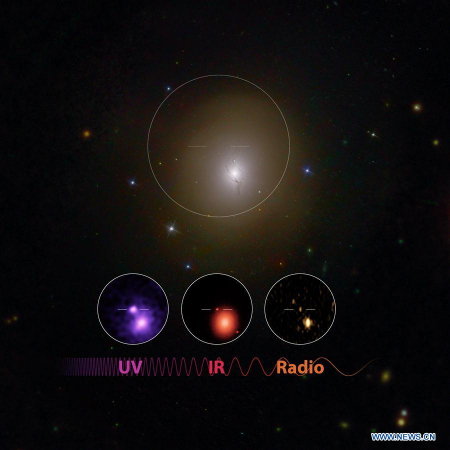
Image made by Caltech and NASA shows the UV/IR/Radio discovery of neutron star merger in NGC 4993. Scientists announced Monday that they have for the first time detected the ripples in space and time known as gravitational waves as well as light from a spectacular collision of two neutron stars. (Xinhua/Robert Hurt of Caltech, Mansi Kasliwal of Caltech, Gregg Hallinan of Caltech, Phil Evans of NASA and the GROWTH collaboration)
Scientists announced Monday that they have for the first time detected the ripples in space and time known as gravitational waves as well as light from a spectacular collision of two neutron stars.
The detection of the gravitational wave signal, called GW170817, was made at 8:41 a.m. EDT (1241 GMT) on August 17 by twin detectors of the Laser Interferometer Gravitational-wave Observatory (LIGO),located in Livingston, Louisiana, and Hanford, Washington.
"GROUNDBREAKING" DETECTION
It was touted as "groundbreaking" and "unprecedented" because all the four gravitational waves detected before came from two black holes orbiting each other and merging.
"The detection of gravitational waves from a binary neutron star merger is something that we have spent decades preparing for," Alan Weinstein, head of Caltech (California Institute of Technology) astrophysical data analysis group for LIGO, said in a statement.
"On that morning, all of our dreams came true."
About two seconds after the latest gravitational wave incident ended, a bright flash of light, in the form of gamma rays, was detected by U.S. space agency NASA's Fermi space telescope.
In the hours, days and weeks following the smashup, other forms of light or electromagnetic radiation -- including X-ray, ultraviolet, optical, infrared, and radio waves -- were detected.
"We quickly established that the two stars were each less than around twice the mass of the sun, putting them in the typical mass range of neutron stars," Weinstein said.
The coincident gamma-ray burst suggested that the stars, unlike black holes, emit light.
Later studies by Caltech and LIGO Scientific Collaboration, a group of more than 1,200 scientists worldwide, found that the two stars were located in NGC 4993, a galaxy about 130 million light years away in the constellation Hydra.
Neutron stars, formed when massive stars explode in supernovas, are the smallest, densest stars known to exist, with a teaspoon of neutron star material having a mass of about one billion tons.
COSMIC MINE
The light-based detections that followed showed that the collision of the neutron stars released newly synthesized heavy elements into the surrounding universe.
That's "the first concrete proof that such smashups are the birthplace of half of the universe's elements heavier than iron, including gold and platinum," the LIGO team said in a statement.
Previously, scientists knew where the lighter elements in the periodic table were synthesized. Most of the hydrogen and helium came from the Big Bang, and elements up to iron are fused in the cores of stars.
"But the origin of half the elements heavier than iron has been uncertain," the team said. "Astronomers have long suspected that they are synthesized in neutron-star collisions through rapid capture of neutrons ... but had no proof."


















































